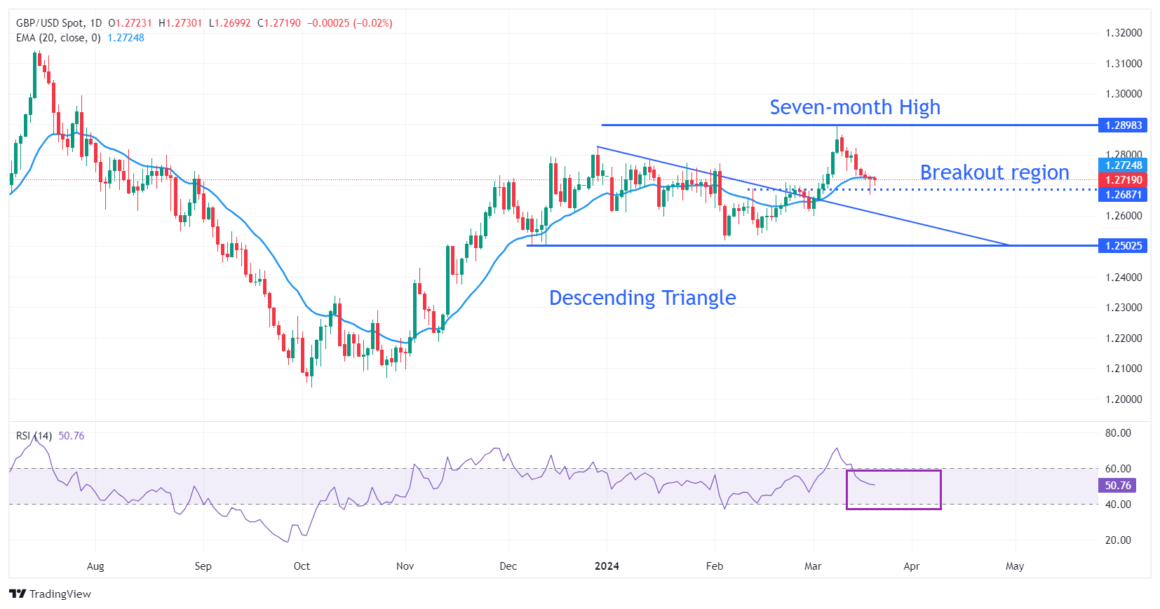The Pound Sterling is expected to face downward pressure following lower-than-expected UK Consumer Price Index (CPI) data for February. With annual headline and core inflation slowing to 3.4% and 4.5% respectively, the softer inflation figures suggest that the Bank of England (BoE) might consider initiating interest rate cuts earlier than previously anticipated by the market.
Investors are bracing for heightened volatility in the Pound Sterling ahead of the BoE’s monetary policy decision on Thursday. While the expectation is for the BoE to maintain interest rates at 5.25%, the soft inflation data could prompt policymakers to offer a slightly dovish outlook on interest rates.
Additionally, investor sentiment remains cautious as they await the Federal Reserve’s policy meeting announcement scheduled for 18:00 GMT. The focus will be on the quarterly updated dot plot and economic projections, with the Fed expected to keep interest rates within the range of 5.25%-5.50%.
Market Movements: Pound Sterling Faces Challenges Amidst Various Factors
The Pound Sterling is anticipated to encounter pressure following softer-than-expected consumer price inflation data for February released by the UK ONS. Both annual headline and core inflation figures fell short of expectations, indicating potential challenges for BoE policymakers in achieving the desired inflation target.
Investors will closely monitor the BoE’s interest rate decision on Thursday, expecting no change in rates but seeking clues on potential rate reductions in the future. The soft inflation data further reinforces the expectation that interest rate cuts may begin as early as August.
Meanwhile, ahead of the Federal Reserve’s monetary policy decision, market sentiment remains cautious. With interest rates expected to remain unchanged, attention will shift to the Fed Chair’s press conference and updates on economic projections.
Technical Analysis: Pound Sterling Faces Resistance
The Pound Sterling faces resistance as it struggles to maintain levels above the 20-day Exponential Moving Average (EMA) around 1.2730. Support is expected near the Descending Triangle breakout region at 1.2700, while a significant barrier lies ahead at the seven-month high of approximately 1.2900.
The Relative Strength Index (RSI) indicates a contraction in volatility, returning to the 40.00-60.00 range.

POUND STERLING FAQS
What is the Pound Sterling?
The Pound Sterling (GBP) is the oldest currency in the world (886 AD) and the official currency of the United Kingdom. It is the fourth most traded unit for foreign exchange (FX) in the world, accounting for 12% of all transactions, averaging $630 billion a day, according to 2022 data. Its key trading pairs are GBP/USD, aka ‘Cable’, which accounts for 11% of FX, GBP/JPY, or the ‘Dragon’ as it is known by traders (3%), and EUR/GBP (2%). The Pound Sterling is issued by the Bank of England (BoE).
How do the decisions of the Bank of England impact on the Pound Sterling?
The single most important factor influencing the value of the Pound Sterling is monetary policy decided by the Bank of England. The BoE bases its decisions on whether it has achieved its primary goal of “price stability” – a steady inflation rate of around 2%. Its primary tool for achieving this is the adjustment of interest rates. When inflation is too high, the BoE will try to rein it in by raising interest rates, making it more expensive for people and businesses to access credit. This is generally positive for GBP, as higher interest rates make the UK a more attractive place for global investors to park their money. When inflation falls too low it is a sign economic growth is slowing. In this scenario, the BoE will consider lowering interest rates to cheapen credit so businesses will borrow more to invest in growth-generating projects.
How does economic data influence the value of the Pound?
Data releases gauge the health of the economy and can impact the value of the Pound Sterling. Indicators such as GDP, Manufacturing and Services PMIs, and employment can all influence the direction of the GBP. A strong economy is good for Sterling. Not only does it attract more foreign investment but it may encourage the BoE to put up interest rates, which will directly strengthen GBP. Otherwise, if economic data is weak, the Pound Sterling is likely to fall.
How does the Trade Balance impact the Pound?
Another significant data release for the Pound Sterling is the Trade Balance. This indicator measures the difference between what a country earns from its exports and what it spends on imports over a given period. If a country produces highly sought-after exports, its currency will benefit purely from the extra demand created from foreign buyers seeking to purchase these goods. Therefore, a positive net Trade Balance strengthens a currency and vice versa for a negative balance.
